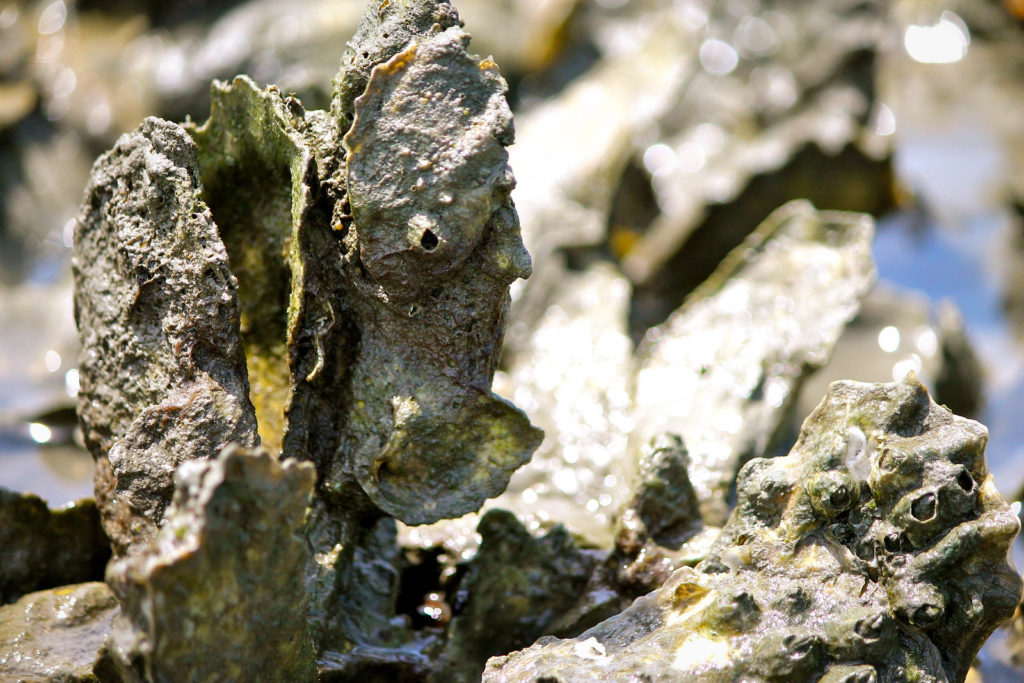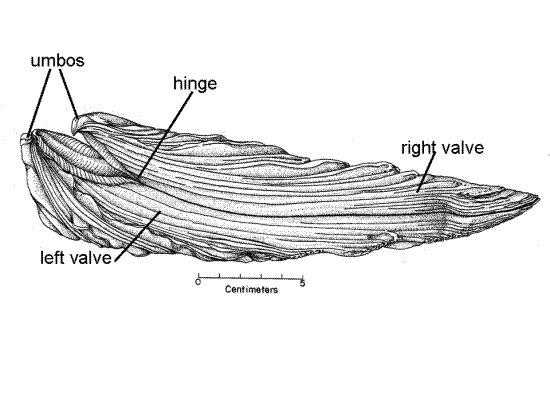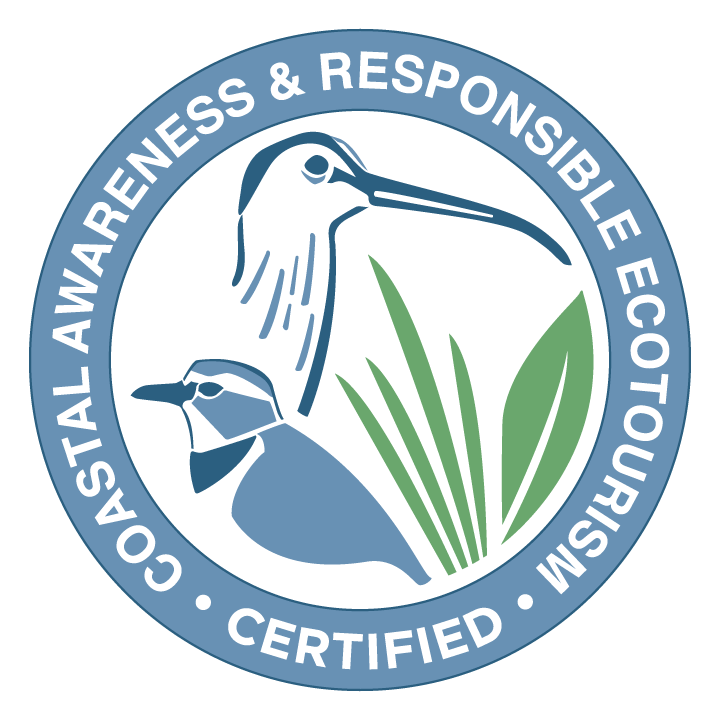Oyster Natural History

Key concepts:
- Taxonomy
- Internal and external features
- Life cycle
- Ecosystem services
- Water quality
Throughout the southeastern United States, the eastern oyster (Crassostrea virginica), grows intertidally (between the tides) and is considered a keystone species. Oyster reefs play functional roles in providing hard substrate for other organisms to attach and grow, providing essential fish habitat for a variety of species like trout red drum and black drum, reducing shoreline erosion, and filtering water thus significantly improving water clarity and controlling excessive growth of algae resulting from nutrient enrichment.
Taxonomy
Eastern oysters belong to the phylum Mollusca and are further classified as bivalves (having two shells). A characteristics of the phylum Mollusca is the presence of a mantle which is an outer layer of tissue that encompasses the organs and secretes the oyster’s calcium carbonate shell. Bivalves are a group of invertebrates that are closely related to other Molluscs like snails, (class: Gastropoda) squid and octopus (class: Cephlapoda).
Kingdom: Animalia
Phylum: Mollusca
Class: Bivalvia
Family: Ostreida
Genus: Crassostrea
Species: virginica
External and internal features

Oysters are bivalves with two shells (valves) that are attached together along a hinge line where the valves come together. The umbo is located on the anterior end of the oyster and is formed during the veliger stage of its life cycle. As the oyster grows, calcium carbonate is deposited building upon the existing shell. The beak is located on the posterior section of the shell and is generally the thinner part of the oyster shell. The right valve is the flatter shaped shell, whereas the left valve is more cup-shaped and is the site of attachment to the substrate. Oyster shell morphology or the shape of the shell varies depending upon environmental factors like salinity, temperature, velocity of currents and the amount of sediment in the surrounding water.

Life cycle
Oysters are broadcast spawners (release sperm and eggs into the water column for external fertilization) and spawn along the coast of Georgia from May to October with a peak spawning period usually occurring in July. Water temperature plays a critical role in determining the seasonal timing of spawning and usually occurs when the water temperature is at least 68o F. Sperm and eggs are released into the water column eggs are fertilized and develop into trochophore larvae which drift with the water currents as part of the plankton. After 24-48 hours, the larvae develop into veliger larvae when they develop “wings” with beating cilia which allow them to feed on other plankton. After a couple of weeks, the larvae develop a foot and are then referred to as pediveligers.
Using their foot, pediveliger larvae explore various hard substrates (e.g. rocks, pilings and ideally, other oysters) in order to select a suitable site to attach and begin a sessile (attached) existence. The pediveliger stage of an oyster’s life cycle serves as a transition form between a planktonic and benthic (bottom dwelling) existence. Adult oysters emit chemical cues to attract pediveliger larvae to existing oyster reef communities. Upon settling and attaching, the pediveliger metamorphosis into juvenile spat and the oyster becomes sessile. Spat reach sexual maturity in 4 months. Depending upon location, oysters can take 12 – 36 months to grow to the harvestable size of 3 inches.
Oyster growth depends on environmental factors such as temperature, salinity, and food supply. Oysters grow when they are on a firm substrate, and when salinities are from 10 to 30 ppt (parts per thousand), however, 15 to 18 ppt is considered the optimum salinity. Other factors that affect growth are water flow, sediment load, and oxygen concentration (measured in parts per million (ppm)). Oxygen levels must be between 3 ppm to 5 ppm for oysters to thrive. A reduction in oyster reefs and shell over the years has resulted in a reduction in the amount of hard surface area available thus increasing the competition for space among oyster larvae.
Ecosystem services

Oysters are considered a keystone species (critical to a healthy ecosystem) and serve many important ecological functions. One important function is that oysters provide critical habitat for many organisms that live on, in and around an oyster reef. Oyster reefs are composed of successive generations of oysters and as older oysters on the bottom die, oyster larvae attach (referred to as spat) on the surface and over time, reefs grow both vertically and horizontally creating space for other organisms to live. The oyster reef is used as a habitat by both transient (organisms that move onto the reef at high tide) and residential organisms that use the reef for food, shelter and as a spawning and nursery area.
Within the oyster reef, the oysters and those organisms associated with the reef create a food web based on the predator-prey relationships among the organisms inhabiting the reef. Oyster predators (whelks, oyster drills, blue crab, mud crabs and cownose rays) are at risk of being preyed upon by other organisms (sea turtles, striped bass, oyster toadfish, and bluefish). There are also examples of commercially important species that use oyster reefs as a habitat (brown shrimp, white shrimp, and blue crab).
Some shorebird species such as the American oystercatcher (Haemotopus palliatus) use large shell rakes for nesting. Such reefs are often more isolated than larger islands, therefore offering some protection against terrestrial predators such as racoons. However, while oyster rakes are often safe from tides during neap (lunar cycle associated with lower high tide levels) periods, spring tides (lunar cycle associated with the highest tide levels) can often result in wash-over of nests and eggs. Birds nesting on such precarious sites balance the advantages and risks that oyster rakes offer to try to maximize their breeding efforts.

Oysters are also capable of reducing shoreline erosion. Oyster reefs reduce the energy of breakwaters by absorbing wave energy before it reaches the salt marsh thus protecting the shoreline against boat wakes and waves.
Water Quality
Oysters are considered indicators of water quality because they (along with other shellfish) filter large volumes of water from the surrounding aquatic environment to obtain food particles (plankton) and dissolved oxygen. An adult oyster is capable of filtering 60 gallons of water per day. Oysters will filter algae, bacteria and some detritus (dead organic material), however they are most interested in phytoplankton that range in size from 3-40 microns (one thousandth of a millimeter) in diameter.
Oysters like other bivalves, are suspension feeders with the ability to select what they want to ingest (particles of higher quality) versus what they don’t want to ingest (particles of lower quality). The size of particle that an oyster can ingest is no greater than 600-900 microns in size. Oyster filter food items (plankton) out of the water by using hair-like structures located on the gills called cilia to set up currents supplying oxygen to the gills. The currents also carry food particles to the gills where they are sorted and eventually carried to the mouth. Structures around the mouth (labial palps), are also instrumental in sorting particles and serve as the structure for moving food particles to the mouth. The particles of lesser nutritional value are concentrated on the mucus of the gills and moved to areas on the mantle and expelled as pseudofeces. Waste from oysters exit through the rectum as feces.

Image courtesy of UGA Marine Extension and Georgia Sea Grant
In addition to the food source, harmful bacteria, viruses and toxic substances present in the water are filtered and concentrated in the living tissue of the oyster. Oysters are capable of accumulating these pollutants and naturally occurring toxins from the water at considerable distances from the source of pollutants. The bio-accumulation of the pollutants can result in changes in growth rate and other biological processes (reproduction) including potential for death.
References
Galtsoff, P. S. (1964). The American oyster, Crassostrea virginica gmelin (Vol. 64). US Government Printing Office.
Manley, J., Power, A., & Walker, R. (2009). Comparison of techniques for off-bottom culture of the eastern oyster, crassostrea virginica (Gmelin, 1791), in Georgia.
